Ptolemaic Dynasty › Ancient Jordan » Ancient origins
Articles and Definitions › Contents
- Ptolemaic Dynasty › Antique Origins
- Ancient Jordan › Ancient History
Ancient civilizations › Historical and archaeological sites
Ptolemaic Dynasty › Antique Origins
Definition and Origins
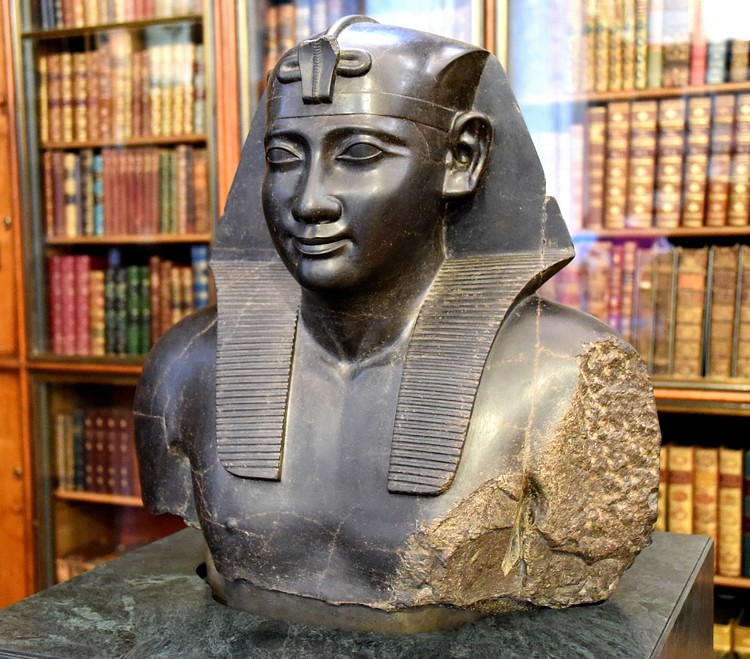
The Ptolemaic dynasty controlled Egypt for almost three centuries (305 – 30 BCE), eventually falling to the Romans. Oddly, while they ruled Egypt they never became Egyptian. Instead, they isolated themselves in the capital city of Alexandria, a city envisioned by Alexander the Great. The city was Greek both in language and practice. There were no marriages with outsiders; brother married sister or uncle married niece. In the end, even the infamous Cleopatra VII remained Macedonian.Except for the first two Ptolemaic pharaohs, Ptolemy I and his son Ptolemy II, most of the family was fairly inept and, in the end, only maintained authority with the assistance of Rome.
A GREEK FAMILY OF EGYPTIAN PHARAOHS
One of the unique and often misunderstood aspects of the Ptolemaic dynasty was that it never became Egyptian. The Ptolemys coexisted as both Egyptian pharaohs as well as Greek monarchs. In every appearance they remained completely Greek, both in their language and traditions. This unique characteristic was maintained through intermarriage; most often these marriages were either between brother and sister or even uncle and niece. This inbreeding was intended to stabilize the family; wealth and power were consolidated. Although it was considered by many an Egyptian and not Greek occurrence – the mother goddess Isis married her brother Osiris – these sibling marriages were justified or at least made more acceptable when critics would allude that even in Greek mythology the gods intermarried; Cronus had married his sister Rhea while Zeus had married Hera.
THE PTOLEMYS COEXISTED AS BOTH EGYPTIAN PHARAOHS AS WELL AS GREEK MONARCHS. THEY REMAINED COMPLETELY GREEK, BOTH IN THEIR LANGUAGE & TRADITIONS.
Of the fifteen Ptolemaic marriages ten were between brother and sister while two were with a niece or cousin. This meant that even the infamous Cleopatra VII, the last Ptolemy to rule Egypt and the subject of playwrights, poets, and movies, was not Egyptian but Macedonian. According to one historian, she was a descendant of such great Greek queens as Olympias, the overly-possessive mother of Alexander. However, in her defense, Cleopatra was the only Ptolemy to learn to speak Egyptian and make any effort to know the Egyptian people. Of course, this inbreeding was less than ideal; jealousy was rampant and conspiracies were common. Ptolemy IV supposedly murdered his uncle, brother, and mother, while Ptolemy VIII killed his fourteen-year-old son and chopped him into pieces.
PTOLEMY I SOTER
The sudden death of Alexander the Great in 323 BCE brought chaos and confusion to his vast empire, for he died without naming an heir or successor, saying instead that the empire was left 'to the best.' Those commanders who had faithfully followed him from Macedon across the desert sands of western Asia were left to decide for themselves the fate of the kingdom. Some wanted to wait until the birth of Roxanne and Alexander's son, the future Alexander IV, while others chose a more immediate and self-serving remedy, simply divide it among themselves. The final decision would bring decades of warand devastation. The vast territory was split among the most loyal of Alexander's generals: Antigonus I the One-Eyed, Eumenes, Lysimachus, Antipater and lastly, Ptolemy, the 'most enterprising' of Alexander's commanders.

Ptolemy_I
Ptolemy I Soter (Savior) (366 – 282 BCE) was a Macedonian nobleman and, according to most sources, the son of Lagos and Arsinoe. He had been a childhood friend of Alexander, his official taster, bodyguard, and even possibly a relative; rumors abound that he was the illegitimate son of Philip II, Alexander's father. After the king's death, he had led the campaign to divide the empire among the leading generals and in the Partition of Babylon, and to his delight, he received the land he had always craved, Egypt. In Ptolemy's eyes, Egypt was ideal. After years of oppression under the Persians, the people of Egypt had welcomed Alexander and his conquering army. The Persian conquerors had been intolerant of the Egyptian customs and religion. Alexander was far more tolerant, even embracing their gods, praying at their temples. He had even built a temple to honor the Egyptian mother goddess Isis. However, in Egypt Ptolemy saw vast potential, albeit selfishly. There was wealth beyond measure, largely dependent on agricultural production; its borders were easy to defend with Libya lying to the west and Arabia to the east (he was wise not to trust his fellow commanders); and it was friendly to his home of Macedon.
Unfortunately, while the partition may have granted Egypt to Ptolemy, there were some who did not trust the cagey commander, namely Perdiccas, the self-appointed successor to Alexander. So Cleomenes of Naucratis, who had been named the Egyptian finance minister by Alexander, was appointed by Perdiccas as an adjunct or hyparchos to watch (or spy) on Ptolemy. Realizing the Perdiccas ploy, Ptolemy knew he had to free himself of Cleomenes, so he accused the unwary minister of 'fiscal malfeasance' - not a completely trumped-up charge - and had him executed. With Cleomenes gone, he could now rule alone without anyone watching over his shoulder, and in doing so, he would establish a dynasty that would last for almost three centuries until the time of Julius Caesar and Cleopatra VII. During Ptolemy's four-decade rule of Egypt, he would put the country on sound economic and administrative footing.
After the death of Cleomenes, Ptolemy I quickly and firmly began to establish himself in Egypt. His sole purpose became making Egypt great again. Reluctantly, however, he became involved in the ongoing Wars of the Successors. While Ptolemy I did not intentionally seek territory outside Egypt, he would, however, take advantage of an occasion if it arose and he would occupy the island of Cyprus around 318 BCE. Another opportunity found him fighting a Spartan named Thribon who had seized the city of Cyrene on the North Africa coast. After a quick, decisive victory, he turned the fallen conqueror over to the city who promptly executed him. Unfortunately, Ptolemy could not avoid some involvement with the other commanders, and he gave refuge to Seleucus and later supported Rhodes against the invading forces of Demetrius the Besieger, son of Antigonus.

Ptolemy I Soter
Still, there was his ongoing rivalry with Perdiccas. The hostility did not subside when Ptolemy stole Alexander's body as it was being transported to a newly built tomb in Macedon. As the king's chiliarch, Perdiccas had established himself securely after Alexander's death, always hoping to reunite the empire. He possessed the signet ring as well as the king's body, preparing to return it to Macedon. However, at Damascus the body inexplicably disappeared. Ptolemy I had stolen and taken the body to Memphis and then to Alexandria where the golden sarcophagus was displayed in the center of the city. Perdiccas, to say the least, was outraged. However, to those in Egypt the legitimacy of the Ptolemaic dynasty lay in its connection to the fallen king.Even in death, he played a major role in both the Egyptian and Ptolemaic imagination. The theft of Alexander was too much for Perdiccas. The long disagreement finally ended in war (322 – 321 BCE). He stepped up his military assault on the Ptolemaic pharaoh, but after three failed attempts to cross the Nile into Egypt and the loss of over two thousand soldiers, his army had had enough and executed him. There were few if any tears among the other commanders for Perdiccas had not been very popular.
PTOLEMY II PHILADELPHUS
Ptolemy I died in 282 BCE, and as his successor he named his son Ptolemy II Philadelphus (Sister-loving) (308 – 246 BCE).The younger Ptolemy had served as co-regent with his father since 285 BCE. Ptolemy II married the daughter of the Thracian regent/king Lysimachus, Arsinoe I. For alliance purposes, after the death of his first wife, Lysimachus had chosen to marry Arsinoe II, the daughter of Ptolemy I and his mistress Berenice, around 300 BCE. It was a marriage he would regret. For reasons unknown – probably to secure the throne of Thrace for her own son – Arsinoe II convinced her husband to kill his oldest son (by his first marriage) and heir on the trumped-up charges of treason. The murder of the popular young commander caused uproar among many of his fellow officers.
After the death of Lysimachus, Ptolemy would marry his sister (and the king's widow) Arsinoe II. Unlike many of his successors, Ptolemy II expanded Egypt with the reclaiming of Cyrene (the city had declared independence from Egypt) and acquisitions in Asia Minor and Syria. He fought two wars – the Syrian Wars – against Antiochus I and Antiochus II (260 – 252 BCE) and would marry his daughter Berenice to Antiochus II. Unfortunately, he also fought and failed in the Chremonidean War against Macedon (267 – 261 BCE). In Egypt, he established trading posts along the Red Sea, completed construction on the Pharos, and enlarged the library and museum. To honor his parents he established a new festival, the Ptolemaeia.
SYRIAN WARS
Apparently, Ptolemy II was one the last truly great pharaohs of Egypt. Many of those who followed failed to strengthen Egypt both internally and externally. Jealousy and in-fighting were common. Upon the death of his father in 246 BCE, Ptolemy III Euergetes (Benefactor) (284 – 221 BCE) came to the throne. He married Berenice II from the Greek city of Cyrene. Among their six children were Ptolemy IV and a princess also named Berenice. The princess' sudden death brought about the Canopus Decree (238 BCE) which, among other proclamations, honored her as a goddess. One interesting suggestion made in the decree was for a new calendar, one that included 365 days with one additional day every four years, but it was not adopted. In 246 BCE Ptolemy III invaded Syria to support his sister's husband Antiochus II in the Third Syrian War against Seleucus II but only acquired towns in Syria and Asia Minor.
His successor and son Ptolemy IV Philopator (Father-loving) (244 – 205 BCE) came to the Egyptian throne in 221 BCE.Keeping with family tradition, he married his sister Arsinoe III in 217 BCE. He gained a small degree of success in the Fourth Syrian War (219 – 217 BCE) against Antiochus III. However, largely ineffective, his only other accomplishment was the building of the Sema, a tomb to honor both Alexander and the Ptolemys. Unfortunately, he and his wife were both murdered in a palace coup in 205 BCE.

Ptolemy V
Ptolemy V Epiphanes (Made-Manifest) (210 – 180 BCE) was the son of Ptolemy IV and Arsinoe III and due to the sudden death of his parents inherited the throne as a small child. He married the Seleucid princess Cleopatra I in 193 BCE.Unfortunately, war and revolt by Seleucid and Macedonian kings with hopes to seize Egyptian lands followed his ascension.Following the Battle of Panium in 200 BCE Egypt lost valuable territory in the Aegean and Asia Minor, including Palestine. In 206 BCE dissidence arose in the Egyptian city of Thebes, and it would remain outside Ptolemaic control for twenty years.
Ptolemy V's successor Ptolemy VI Philometor (Mother-Loving) began his reign, like his father, as a small child, serving with his mother until her unexpected death in 176 BCE. Despite having serious troubles with his brother, the future Ptolemy VIII Euergetes II (Benefactor), he married his sister Cleopatra II and began his tumultuous reign. Egypt was invaded twice (169 – 164 BCE) by Antiochus IV; his army even approached the city of Alexandria. With the assistance of Rome, Ptolemy VI regained nominal control of Egypt, but his reign - ruling with his brother and wife - remained full of unrest. In 163 BCE his brother and he finally reached a compromise whereby Ptolemy VI acquired Egypt while Ptolemy VIII ruled Cyrene. In 145 BCE Ptolemy VI died in battle in Syria.
CIVIL WAR
Little is known of the reign or person known as Ptolemy VII or if indeed he ever really reigned, but Ptolemy VIII, the younger brother of Ptolemy VI, stepped onto the throne in 145 BCE. In true Ptolemaic fashion, he married his brother's widow, Cleopatra II, only to replace her with her daughter, his niece, Cleopatra III. A civil war ravaged Egypt lasting from 132 to 124 BCE; it especially devastated the capital city of Alexandria, which happened to hate Ptolemy VIII. Actually, this was not uncommon for there was little love if ever between the city's citizens and the royal family. This intense loathing brought about extreme persecution and expulsion for the inhabitants of the city. Finally, an amnesty was reached in 118 BCE.

Ptolemaic King
Ptolemy VIII was succeeded by his eldest son in 116 BCE. Ptolemy IX Soter II (Savior) (142 – 80 BCE) was also known as Lathyrus (Chickpea). Like many of his predecessors, he would marry two of his sisters, Cleopatra IV, mother of Berenice IV, and Cleopatra V Serene who gave him two sons. He ruled jointly with his mother Cleopatra III until 107 BCE when he fled to Cyprus after being overthrown by his brother. He regained the throne in 88 BCE and ruled until his death in 80 BCE.
THE RISE OF ROME
The next few pharaohs made little impact if any on Egypt, and for the first time, a rising power in the west made a major impact, Rome. Ptolemy X Alexander I (140 – 88 BCE) was the younger brother of Ptolemy IX and had served as governor of Cyprus until his mother brought him to Egypt in 107 BCE, replacing his brother. In 101 BCE he supposedly murdered his mother Cleopatra IV. He then married the daughter of Cleopatra V Serene (his niece), Berenice III. He left Egypt after being expelled in 88 BCE only to be lost at sea. He was succeeded briefly by his youngest son Ptolemy XI Alexander II (100 – 80 BCE). After awarding Egypt and Cyprus to Rome, Ptolemy XI was placed on the throne by the Roman general Cornelius Sullaand ruled jointly with his step-mother Cleopatra Berenice until he murdered her. Unfortunately, he was then himself murdered by the Alexandrians.
Ptolemy XII Neos Dionysos (also known as Auletes) was another son of Ptolemy IX succeeding Ptolemy XI in 80 BCE. He married his sister Cleopatra Tryphaena. Unfortunately, his close relationship with Rome caused him to be despised by the Alexandrians and expelled in 58 BCE. However, he regained the throne with the assistance of the Syrian governor Gabinius and was only able to remain through bribes and his ties to Rome as the Roman Senate actually distrusted him.

Ptolemy XII Bust
The next pharaoh Ptolemy XIII (63 – 47 BCE) was the brother and husband of the infamous Cleopatra VII. His time on the throne was short-lived. He had joined unsuccessfully with his sister Arsinoe in a civil war, choosing to oppose both Julius Caesar and Cleopatra in a fight for the throne. Initially, he had expected to gain favor with Caesar when he killed the Roman general Pompey, who had sought refuge in Egypt and presented the severed head to Caesar. However, the Roman commander grew irate because he wanted to kill Pompey himself. Ptolemy XIII's army was defeated after an intense battle, and he drowned in the Nile River when his boat overturned. Arsinoe was taken to Rome in chains (later to be released).
Following Ptolemy XIII was another brother Ptolemy XIV (59 – 44 BCE) who had served briefly as governor of Cyprus and later married his sister (on the wishes of Caesar), ruling until his abrupt death possibly caused by poisoning on the orders of his big sister.
THE LAST PTOLEMAIC PHARAOH, CLEOPATRA
Lastly, the final pharaoh of Egypt was Cleopatra VII who is known to history as simply Cleopatra. She ruled Egypt for 22 years, controlling much of the eastern Mediterranean Sea. Like many of the women of her era, she was highly educated, being groomed for the throne by her father Ptolemy XII in the traditional Greek ( Hellenistic ) manner. She endeared herself to the Egyptian people, participating in many Egyptian festivals and ceremonies as well as being the only Ptolemy to learn the Egyptian language besides speaking Hebrew, Ethiopian, and other dialects.
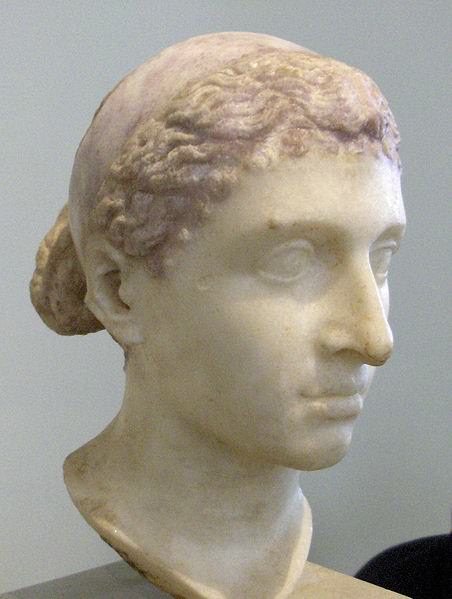
Bust of Cleopatra
To secure the throne after defeating her brothers and sister, she realized she had to remain friendly with Rome. Her relationship with Julius Caesar has been the subject of the dramatists and poets for centuries. With the death of Caesar and the balance of power in Rome in question, she sided, unfortunately, with the Roman general Mark Antony, only to lose it all at the Battle of Actium. Regrettably, she failed to find compassion in Octavian, the future Emperor Augustus and committed suicide. Her sons by Caesar and Antony, Caesarion (Ptolemy XV) and Antyllus were put to death by Octavian. Her other children, Alexander Helos, Cleopatra Serene, and Ptolemy Philadelphus were younger and allowed to live. Like with the rest of the Mediterranean - described once as a Roman lake - Egypt submitted to Roman rule and the power of the Ptolemys ended.
HELLENIZATION & ALEXANDRIA
One of the most significant features of Ptolemaic rule was its policy of Hellenization, integrating Greek language and culture into Egyptian daily life. There was no attempt to become assimilated into Egyptian civilization. One of Ptolemy I's first moves was to relocate the center of government from its traditional location at Memphis - it would remain the religious center - to the newly built city of Alexandria. Alexandria had a more strategic location, much closer to both the Mediterranean Sea and Greece. Because of this move, Alexandria grew into more of a Greek rather than Egyptian city. In fact, the Ptolemys would rarely leave the city and then only to take a pleasure cruise down the Nile. As with much of the former Alexandrian empire, Greek would become the language of government and commerce.
Ptolemy I also established Alexandria as the intellectual center of the Mediterranean when he built a massive library and museum there. While the museum provided seating for quiet reflection, the library amassed a collection of thousands of papyrus scrolls, attracting men of philosophy, history, literature, and science from all over the Mediterranean for decades to come. Ptolemy I's advisor on the project was Demetrius of Phaleron, a graduate of Aristotle ’s Lyceum in Athens ; the library truly became a center of Hellenistic culture. Unfortunately, the library and its contents were destroyed in a series of fires during its years under Roman control.
In the city's harbor, Ptolemy began the construction of the Pharos, a massive lighthouse (to be completed by his son Ptolemy II). This unique lighthouse was an immense structure of three stories. Its beacon was visible for miles and was lit both day and night, eventually becoming one of seven wonders of the ancient world. Aside from Alexandria, another city, less glamorous, was built in Upper Egypt: Ptolemais was founded as a center for the influx of newly arrived Greek residents.

Lighthouse of Alexandria
While it may appear that Ptolemy I intended to transform Egypt into another Greece, in many ways he still respected the Egyptian people and recognized the importance of religion and tradition to their society. Both he and his successors supported the many local cults. To keep peace with the temple priests, he restored numerous religious objects stolen by the Persians.However, while the old Egyptian gods were respected – one did not want to anger the gods – two new cults arose: the first was dedicated to Alexander the Great, which for the Greek population served as a way to express their continued loyalty to the Ptolemys. A second cult, which never gained popularity, was devoted to the god of healing Serapis. Locally, the temple priests remained as a part of the ruling class – another test of their allegiance to the Ptolemys.
Lastly, while the capital may have been moved, the basic administrative structure was retained, although many of the Egyptian scribes had difficulty writing in Greek. Egypt had a closely controlled economy; much of the land was royal land and permission was needed to fell a tree or even to breed pigs. Record keeping was important, all land was surveyed and livestock inventoried. Of course, since Egypt had an economy based on agriculture, taxes based on the census and land surveys were essential. Under Cleopatra VII there was a salt tax, a dike tax, and even a pasture tax. Fishermen even had to relinquish twenty-five percent of their catch.
Ancient Jordan › Ancient History
Definition and Origins
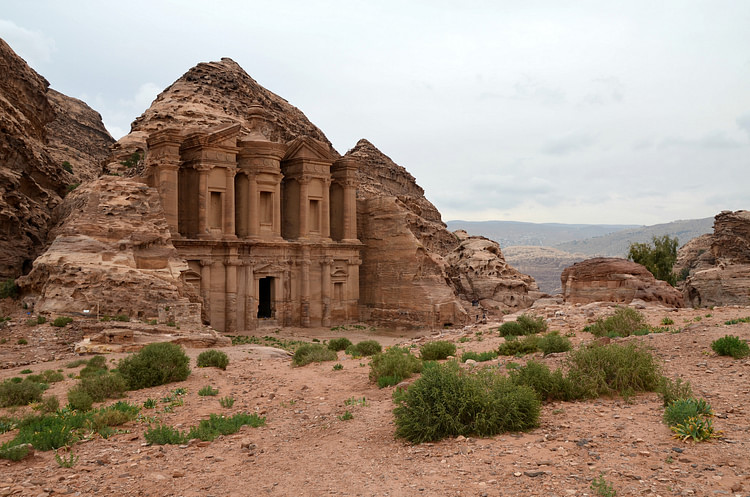
Jordan is a country in the Near East bordered by Israel, Syria, Iraq, and Saudi Arabia which was part of the Land of Canaan in ancient times. The country is named for the River Jordan which flows between modern-day Jordan and Israel and whose name means "to descend" or "flow downwards". The region has a long history as an important trade center for every major empire from the ancient world to the present age (the Akkadian to the Ottoman empire) and numerous sites in the country are mentioned throughout the Bible.
Alexander the Great (r. 336-323 BCE) founded cities in the region (such as Gerasa) and the Nabateans carved their capital city of Petra there from sandstone cliffs. Early in its history the area attracted and inspired traders, artists, philosophers, craftsmen and, inevitably, conquerors all of whom have left their mark on the history of the modern-day country.
Jordan, formally known as The Hashemite Kingdom of Jordan, has been an independent nation since 1946 CE after thousands of years as a vassal state of foreign empires and European powers and has developed into one of the most stable and resourceful nations in the Near East. Its capital city, Amman, is considered one of the most prosperous in the world and a popular destination for tourists. The history of the region is vast, going back more than 8,000 years, and encompassing the tale of the rise and fall of empires and the evolution of the modern state.
JERICHO, CLAIMED TO BE THE OLDEST CONTINUOUSLY INHABITED CITY IN THE WORLD, HAS AN APPROXIMATE FOUNDING DATE OF 9,000 BCE.
EARLY HISTORY
Archaeological excavations date human habitation in the region of Jordan back to the Paleolithic Age (around two million years ago). Tools such as stone hand-axes, scrapers, drills, knives, and stone spear points, dated to this time period, have been found in various locations throughout the country. The people were hunter-gatherers who led a nomadic life moving from place to place in search of game. In time, they began building permanent settlements and establishing agricultural communities.
The Neolithic Age (c. 10,000 BCE) saw the rise of stable, sedentary communities and the growth of agriculture. These small villages eventually became urban centers with their own industry and initiated trade with others. Large urban centers developed such as the city of Jericho, claimed to be the oldest continuously inhabited city in the world, with an approximate founding date of 9,000 BCE.
According to scholar G. Lankester Harding:
[Cities like Jericho provide evidence of] far higher culture than we had hitherto suspected, for here was not merely a village of well-built houses with fine plaster floors, but there was a great stone wall all around the settlement with a ditch or dry moat in front of it. This implies a high degree of communal organization, of subordinating the personal interests to those of the many. (29)
Communal interests are also evident in the ancient monuments raised at this time. Throughout the Neolithic Age the people constructed megalithic dolmens across the land (very similar in size, shape, and methods used to those of Ireland ). These dolmens are thought to be monuments to the dead or possibly passageways between worlds. These dolmens are often found in fields of circled stones whose meaning remains unclear but it is obvious that the builders would have had to work in groups for a common cause to create these sites.
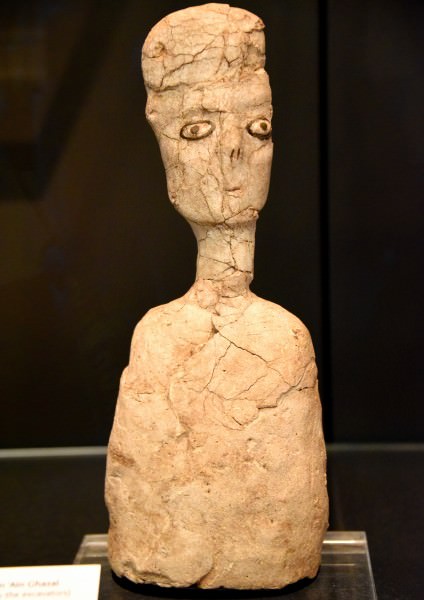
Lime Plaster Statue from Ain Al-Ghazal
The dolmen sites were most likely religious in nature and visited for worship, divination, and festivals by the people of the nearby cities. The largest settlement of the Neolithic Age in Jordan was Ain Ghazal located in the north-west (near the present-day capital of Amman). Inhabited c. 7000 BCE, Ain Ghazal was an agricultural community whose artisans created some of the most striking anthropomorphic statuary in early history. The statues found at Ain Ghazal are among the oldest, if not the oldest, in the world today.
The community had over 3,000 citizens and engaged in trade and the manufacture of pottery which increased the wealth of the people individually and the city collectively. Ain Ghazal continued as a prosperous settlement for 2,000 years between c.7,000 BCE and 5,000 BCE when it was abandoned, most likely due to overuse of the land.
THE HYKSOS & EGYPTIANS
The Chalcolithic and Bronze Ages (c. 4500-3000 and 3000-2100 BCE, respectively) saw further developments in architecture, agriculture, and ceramics. The Ghassulian Culture, centered around the site of Talailat Ghassul in the Jordan Valley, rose to prominence in the Chalcolithic Age displaying inordinate skill in smelting copper, ceramics, and intricacies in architectural design.
The Bronze Age settlement of Khirbet Iskander (founded c. 2350 BCE) rose by the banks of the Wadi Wala stream and was a prosperous trading community until the arrival of invaders who destroyed towns, villages, and cities throughout Jordan in c.2100 BCE. The identity of these aggressors is unknown but they were most likely the armies of the Gutians whose invasions toppled the Akkadian Empire founded by Sargon the Great (r. 2334-2279 BCE) beginning in c. 2193 BCE; the region of Jordan, of course, was part of this empire. The Sea Peoples have been suggested as the invaders by some scholars but the date is too early for their incursions in the area.
Whoever they were, these invaders were then driven out by another group who migrated to the area (possibly as early as 2000 BCE), the Hyksos, who brought a completely different culture to Jordan and established themselves as the ruling class. In time, the Hyksos of Jordan would amass enough power to conquer Egypt and would hold both countries until driven out by the Egyptians in c. 1570 BCE by Ahmose I (c. 1570-1544 BCE). Some scholars argue that the Hyksos (so-called by the Egyptians; the name by which they called themselves is unknown) were indigenous to Jordan while others claim they were foreign invaders; whichever the case, they permanently changed life in Jordan by introducing the horse, composite bow, and chariot to armed conflict, introducing better methods of irrigation, and developing better systems of defense for walled cities.
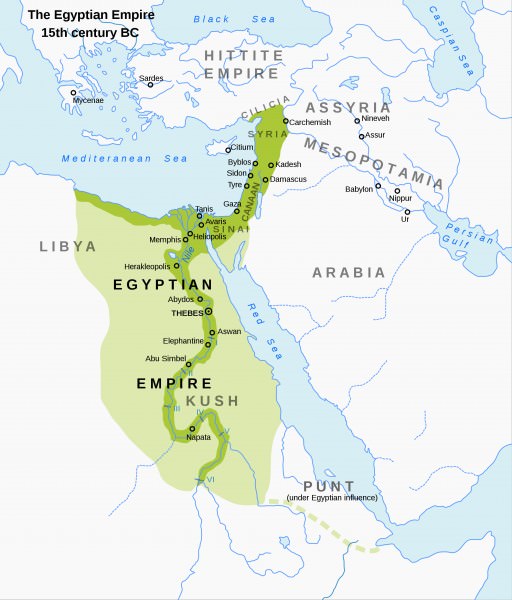
Map of the New Kingdom of Egypt, 1450 BCE
The region of modern-day Syria, Jordan, Lebanon, and Israel (the Levant ) were in continuous trade with other areas and civilizations throughout these periods. Writing in Mesopotamia developed c. 3500 BCE as a means of long-distance communication in trade and yet these regions, which were literate from at least 3000 BCE, did not adopt a system of writing until c. 2000 BCE for reasons which are unclear. Inscriptions such as signs and symbols were created but no complete scriptseems to have been formulated. Writing did not develop in Jordan until after the Egyptians had overthrown the Hyksos in c.1570 BCE.
THE REGION FLOURISHED TO SUCH A GREAT DEGREE THAT IT WOULD BE REFERRED TO IN THE BIBLE AS A GLORIOUS LAND “FLOWING WITH MILK & HONEY”.
Once the Hyksos were driven out of Egypt, the Egyptians pursued them through Jordan, establishing military posts which grew into stable communities. Under the later reign of the Egyptian Queen Hatshepsut (1479-1458 BCE) and her successor Thuthmose III (1458-1425 BCE), trade flourished. Thuthmose III established Egyptian rulers throughout the larger region of Canaan bringing stability, peace, and prosperity. The region flourished to such a great degree that it would be referred to as a glorious land “flowing with milk and honey” centuries later in various books of the Bible.
JORDAN IN THE BIBLE & THE IRON AGE
The cities of Gerasa and Gadara (modern-day Jerash and Umm Qais, respectively) are mentioned in the Book of Mark 5:1-20 and the Book of Matthew 8:28-34. Both of these passages relate the story of Jesus driving evil demons from possessed people into a herd of pigs. The story in Mark, considered the earlier of the two, places the event in Gerasa while Matthew's version has it in Gedara. Mark mentions how, after the miracle, the man who had been demon-possessed relates the miracle to all the people of the Decapolis; the Decapolis was the term for the ten cities on the eastern edge of the Roman Empire at that time and both Gerasa and Gadara were among them.
The region of modern-day Jordan is mentioned a number of times in the Bible's Old Testament as part of the narratives which make up the books of Genesis, Exodus, Deuteronomy, Numbers, Joshua, and others concerning the land of the Israelites, their enslavement in Egypt, and their deliverance to a promised land which then must be conquered. The events related are thought to have occurred during the latter part of the Bronze Age (c. 2000-1200 BCE) although there are discrepancies between the biblical accounts and the archaeological record.
Among the discrepancies most frequently noted by scholars is the fact that the region of Jordan mentioned in the books of Exodus, Numbers, and Joshua is clearly inhabited while the archaeological record indicates a largely unoccupied country. The battles said to have been fought by the Hebrews in Numbers and in Joshua also seem to have left behind no archaeological record. It should be noted, however, that the city of Jericho, famous for its fall to Joshua (Joshua 6:1-27), does show evidence of a violent destruction c. 1200-1150 BCE during the Bronze Age Collapse.
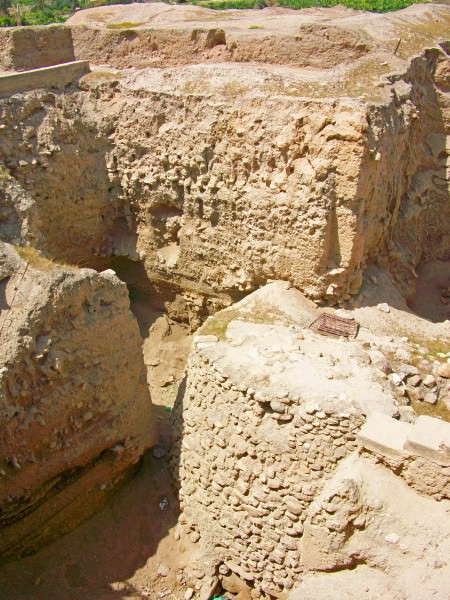
Walls of Jericho
Mount Nebo in Jordan is the spot where Moses is said to have been allowed a glimpse of the Promised Land before he died (Deuteronomy 43:1-4) and Jordan was the land of the Midianites where Moses took refuge after his flight from Egypt in Exodus (Exodus 2:15) and the region in which he encountered the burning bush which sent him back on his mission to free his people from bondage (Exodus 3:1-17). He is said to be buried on Mount Nebo, originally a site sacred to the Moabites and their gods.
The beginning of the Iron Age (c. 1200-330 BCE) in the region was initiated by the invasion of the Sea Peoples, a mysterious culture whose identity scholars still debate. Some have claimed they are the Philistines of the Bible while others have suggested they were Etruscan, Minoan, Mycenaean, or other nationalities. No single claim identifying them has been widely accepted nor is it likely one will be in the near future as the extant inscriptions available only state that these people came from the sea, not which sea nor even from which direction.
The Sea Peoples arrived on the coast of Canaan c. 1200 BCE with an advanced knowledge of metallurgy and their iron weapons were far superior to the stone and copper blades and spears of their opponents. While the Sea Peoples were invading from the south, the biblical record tells of great battles between the Israelites and the Moabites and Midianites in the Book of Judges as well as raids on Israelite settlements by the Ammonites from northern Jordan. The Jordanian kingdoms of Edom in the south, Moab in the center, and Ammon in the north all grew in power during this time.
The Mesha Stele (also known as the Moabite Stone, c. 840 BCE) records a battle fought between Mesha, king of Moab, and three kings of Israel. The narrative on the stele corresponds to the account of the event given in II Kings 3 in which Joram of Israel and Jehosophat of Judah go to war to put down a Moabite rebellion. The Mesha Stele is among the best-known artifacts corroborating a biblical narrative even though some scholars have questioned its meaning and even its authenticity.
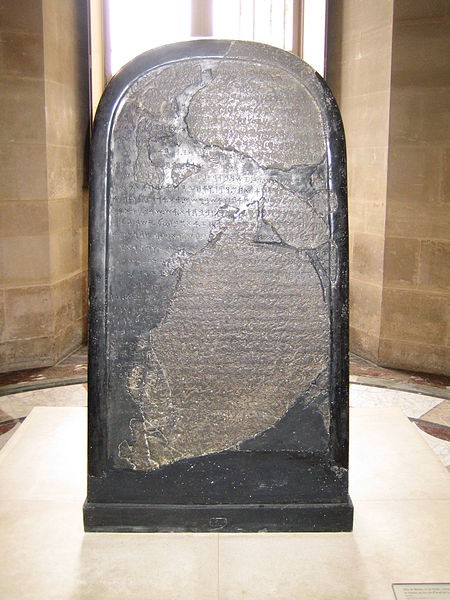
Mesha Stele
The dispute over whether the Mesha Stele supports the biblical narrative is typical of arguments over interpretation not only of objects but of ancient texts. Those scholars who equate the Sea Peoples with the Philistines interpret the Books of I and II Samuel, which significantly feature the Philistines, as a narrative of the Sea Peoples. These books tell the story of the rise of King Saul (c.11th century BCE) over the Israelites and David's defeat of the Philistines in slaying their champion, Goliath, in single combat.
Most of what is known of the Sea Peoples comes from Egyptian records which claim that they were defeated by Rameses III in 1178 BCE near the Egyptian city of Xois and, afterwards, they vanish from the historical record. If this claim, along with Saul's and David's traditional dates, is accepted then the Philistines could be the Sea Peoples who invaded Egypt following their battles with Saul and David. This is far from certain, however, and no consensus on this subject has been reached.
Scholarly agreement is also divided on whether the Sea Peoples were responsible for the devastation of cities throughout the region of Canaan or whether this was the result of the general Joshua and his campaigns of conquest in the region, claiming it as the promised land for his people (books of Numbers and Joshua). Either way, the introduction of iron weapons to the region changed the dynamics of battle, favoring those armed with them, as the Assyrian military machine proved when they took the country. The Assyrians were considered invincible in battle; largely due to their superior weaponry.
THE GREAT EMPIRES & THE NABATEANS
The Assyrian Empire, and its continuation the Neo-Assyrian Empire, both employed iron weapons in conquest and became the greatest and most extensive political power in the world up to that time. Under the Assyrian king Tiglath Pileser I (1115-1076 BCE) the region of the Levant was firmly taken under Assyrian control and would remain part of the empire until its fall in 612 BCE.
The Babylonian Empire then took possession of the land until it was taken by Cyrus the Great, founder of the Achaemenid Empire (549-330 BCE), also known as the Persian Empire, which then fell to Alexander the Great in 331 BCE and became part of his emerging empire. Prior to Alexander's invasion, a unique culture grew up in Jordan whose capital city has become one of the most recognizable images from the ancient world and a popular tourist attraction in the present day: the Nabateans and their city of Petra.
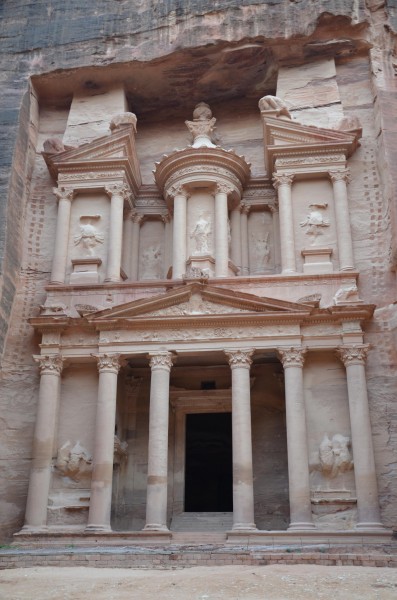
The Treasury, Petra
The Nabateans were nomads from the Negev Desert who arrived in the region of modern-day Jordan and established themselves sometime prior to the 4th century BCE. Their city of Petra, carved from sandstone cliffs, may have been created at this time but possibly earlier. The Nabateans initially gained their wealth through trade on the Incense Routes traveling between the Kingdom of Saba in southern Arabia and the port of Gaza on the Mediterranean Sea. By the time they had established Petra, they were also in control of other cities along the Incense Routes and were able to tax caravans, provide protection, and control the lucrative spice trade.
The famous facade of Petra, known today as The Treasury, was almost certainly originally a tomb or mausoleum and, contrary to popular imagination, does not lead into any intricate maze of hallways but only a fairly short and narrow room. The more spacious dwellings which make up the rest of the cliff city attest to the Nabateans' wealth as traders who had enough disposable income and manpower to be able to afford such an intricate and timely construction.
The name `Petra' means 'rock' in Greek ; the city was originally called Raqmu (possibly after an early Nabatean king) and is mentioned in the Bible and in the works of writers such as Flavius Josephus (37-100 CE) and Diodorus Siculus (1st century BCE). At the height of the Nabatean Kingdom, the Jordan region enjoyed great prosperity and not only in and around the city of Petra. The Nabateans were certainly the wealthiest but people of other nationalities shared in their good fortune as well.
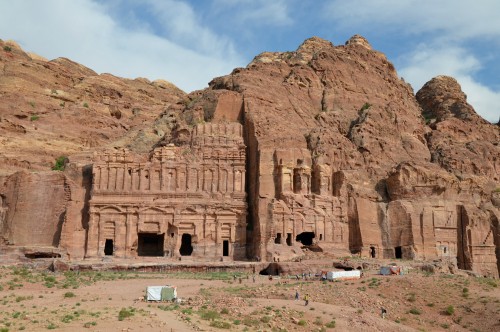
Nabataean Tombs of Petra
In c. 200 BCE the governor of Ammon, Hyrcanus, had his elaborate fortress-palace Qasr Al-Abd ("Castle of the Servant") built which would have required a huge amount of disposable income. Flavius Josephus describes the palace (which he understood as a fortress) in glowing terms as “built entirely of white stone” on a grand scale, including a large reflecting pool, and how its walls were carved with "animals of a prodigious magnitude" as well as banquet halls and living quarters supplied with running water (Merrill, 109). Ruins of this structure survive today near Araq al-Amir, although in a greatly diminished state from Josephus' time, but still attesting to the wealth and vision of the man who commissioned it.
The first historically attested king of the Nabateans was Aretas I (c. 168 BCE) and so, although the Nabateans had established themselves in the region centuries before, the Kingdom of Nabatea is dated from 168 BCE to 106 CE when it was annexed by Rome. The Nabateans had a highly developed culture in which art, architecture, religious sensibilities, and trade all flourished. Women had almost equal rights, could serve as clergy, and even reign as autonomous monarchs. The most important deities of the Nabatean pantheon were female and women most likely would have served as their high priestesses.
To solve the problem of a reliable water supply in the arid region, the Nabateans engineered a series of wells, aqueducts, and dams whose efficiency was unrivalled in their day. With access to water, and established in some of the most inaccessible areas of the region, the Nabateans were able to fend off aggressors attracted by their wealth. They could not hold out long against the superior might of Rome, however, which steadily took their territories and absorbed their trade routes until finally taking the entire kingdom and renaming the region Arabia Petrea in 106 CE under the emperor Trajan (98-117 CE).
ROME, ISLAM, & THE MODERN STATE
The Romans revitalized much of the region (although Nabatean cities such as Petra and Hegra were neglected), creating a powerful trade center at Gerasa and another called Philadelphia at the site of Ammon, now Amman, the capital city of modern-day Jordan. The city of Gedara flourished under the Romans. Gedara was the birthplace of the Roman poet and editor Meleager (1st century CE) and had earlier inspired the work of the Epicurean philosopher and poet Philodemus (c. 110-35 BCE). The Romans certainly benefited from the resources of the region, as well as from the recruits they pressed into their armies as conscripts and auxiliaries, but also improved the area as they built roads, temples, and aqueducts which turned large areas of the region into fertile landscape and encouraged prosperous trade. Gerasa became one of the wealthiest and most luxurious provincial cities of the Roman Empire at this time.
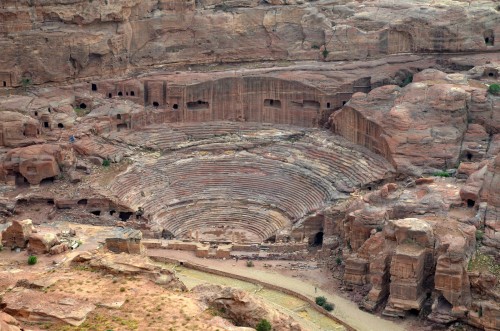
Theatre of Petra
Even so, Rome began to decline steadily throughout the 3rd century CE and faced serious challenges as the 4th century CE began. As Rome struggled with internal difficulties and invasions, the region which would become Jordan suffered along with all the other provinces. The semi-nomadic Tanukhids gained power in and around the area in the 3rd century CE and their most famous leader, Queen Mavia (c. 375-425 CE) led a revolt against Rome, most probably provoked by the empire's insistence on Tanukhid auxiliaries for the army.
As the Tanukhids were originally part of the Nabatean tribal confederacy, it is thought she would have controlled the areas formerly comprising the Kingdom of Nabatea. Whether this is so, she was powerful enough to defy Rome, negotiate a peace on her own terms, and later send cavalry units to assist in the defense of Constantinople following Rome's defeat at the Battle of Adrianople in 378 CE.
When Rome fell in the west (476 CE), the eastern part continued as the Byzantine Empire ruling from Constantinople. In the 7th century CE the Arab Invasion swept across the region, converting the people to Islam, which then brought these people into conflict with the Byzantines. The region of modern Jordan became a part of the Umayyad Empire, the first Muslim dynasty, which ruled from 661-750 CE. Under the Umayyad Empire, Jordan thrived but was neglected by the next ruling house, the Abassids (750-1258 CE) when they withdrew their support from the area, moving the capital from Damascus, just north of Jordan, to Kufa and then Baghdad, significantly further away.
O Califado Fatmid (909-1171 EC, que foi absorvido pelos Abassids) tomou a Jordânia durante sua expansão e iniciou renovações de templos, edifícios e estradas, como fez o Império Otomano (1299-1923 CE) que veio depois dos Abássidas. Os exércitos otomanos derrotaram as forças do Império Bizantino em 1453 CE, acabando com a influência ocidental na região.
Durante a Primeira Guerra Mundial (1914-1918 DC), os otomanos ficaram do lado da Alemanha e das Potências Centrais. A Revolta Árabe de 1916 EC, que começou na Jordânia, enfraqueceu significativamente o Império Otomano enquanto lutava contra as Potências Aliadas e, quando foram derrotados, o império foi dissolvido em 1923 EC. A Jordânia tornou-se então um mandato do Império Britânico até que conquistou sua independência em 1946, após a Segunda Guerra Mundial. Hoje, a região é conhecida como o Reino Hachemita da Jordânia, um estado autônomo com um futuro brilhante - e um passado longo e ilustre.
LICENSE:
Article based on information obtained from these sources:with permission from the Website Ancient History Encyclopedia
Content is available under License Creative Commons: Attribution-NonCommercial-ShareAlike 3.0 Unported. CC-BY-NC-SA License